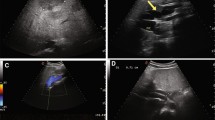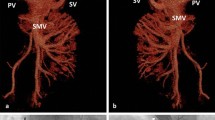Abstract
Background
Congenital portosystemic shunt (CPSS) is a rare congenital portal malformation. 35.5% of CPSS is intrahepatic. Certain intrahepatic CPSS cases can be spontaneously closed within 2 years after birth. However, the intrahepatic CPSS with clinical symptoms or large shunt requires immediate treatment. In the present study, we used a laparoscopic ligation of portosystemic shunt to treat one newborn case.
Materials and methods
An abnormal shunt between the portal and the hepatic vein was initially detected by a prenatal ultrasound in one newborn infant. The postnatal ultrasound and CT indicated a connection between the left portal and hepatic vein and a venous cyst at the anterior edge of the left liver. Owing to the hyperammonemia and the large shunt from the portal into the hepatic vein, the infant was treated with a laparoscopic ligation of the shunt. During the operation, the left portal vein and its branches were dissected and the anterior branch of the left portal vein was clamped using a Hem-o-lok. The venous cyst was sutured and ligated using a prolene suture.
Results
The surgery was completed successfully. The duration of the operation time was 60 min. The postoperative hospital stay was 3 days. The preoperative portal angiography indicated an intrahepatic shunt between the left portal and the left hepatic vein and a venous cyst. Postoperative portal angiography indicated the disappearance of the abnormal shunt and the venous cyst. The portal pressure was increased from the preoperative 6 cmH2O to the postoperative 12 cmH2O. The duration of the follow-up was 22 months. Following surgery, the level of serum ammonia returned to normal. The postoperative CT demonstrated that the abnormal shunt had disappeared. No symptoms of portal hypertension were noted following surgery, such as splenomegaly, hypothrombocytopenia, and upper gastrointestinal bleeding.
Conclusion
The laparoscopic ligation of portosystemic shunt is suitable for the treatment of the intrahepatic CPSS in the newborn patient.





Similar content being viewed by others
References
Bernard O, Franchi-Abella S, Branchereau S et al (2012) Congenital portosystemic shunts in children: recognition, evaluation, and management. Semin Liver Dis 32(4):273–287
Shapiro RS, Winsberg F, Stancato-Pasik A et al (1993) Color Doppler sonography of vascular malformations of the liver. J Ultrasound Med 12(6):343–348
Gitzelmann R, Forster I, Willi UV (1997) Hypergalactosaemia in a newborn: self-limiting intrahepatic portosystemic venous shunt. Eur J Pediatr 156(9):719–722
Ono H, Mawatari H, Mizoguchi N et al (2010) Clinical features and outcome of eight infants with intrahepatic porto-venous shunts detected in neonatal screening for galactosaemia. Acta Paediatr 87(6):631–634
Chiaie DL, Neuberger P, Kalle TV (2008) Congenital intrahepatic portosystemic shunt: prenatal diagnosis and possible influence on fetal growth. Ultrasound Obstet Gynecol 32(2):233–235
Sagiv-Friedgut K, Witzling M, Dalal I et al (2007) Congenital patent ductusvenosus: an association with the hyper IgE syndrome. J Pediatr 150(2):210–212
Uchino T, Endo F, Ikeda S et al (1996) Three brothers with progressive hepatic dysfunction and severe hepatic steatosis due to a patent ductus venosus. Gastroenterology 110(6):1964–1968
Noe JA, Pittman HC, Burton EM (2006) Congenital absence of the portal vein in a child with Turner syndrome. Pediatr Radiol 36(6):566–568
Stringer MD (2008) The clinical anatomy of congenital portosystemic venous shunts. Clin Anat 21(2):147–157
Murray CP, Yoo SJ, Babyn PS (2003) Congenital extrahepatic portosystemic shunts. Pediatr Radiol 33(9):614–620
Kieran MW, Vekemans M, Robb LJ et al (1992) Portohepatic shunt in a Down syndrome patient with an interchange trisomy 47, XY,-2,+der(2), +der(21)t(2;21)(p13;q22.1)mat. Am J Med Genet 44(3):288–292
Ohno T, Muneuchi J, Ihara K et al (2008) Pulmonary hypertension in patients with congenital portosystemic venous shunt: a previously unrecognized association. Pediatrics 121(4):e892–e899
Massin M, Verloes A, Jamblin P (1999) Cardiac anomalies associated with congenital absence of the portal vein. Cardiol Young 9(5):522–525
Kohda E, Saeki M, Nakano M et al (1999) Congenital absence of the portal vein in a boy. Pediatr Radiol 29(4):235–237
Eroglu Y, Donaldson J, Sorensen LG et al (2004) Improved neurocognitive function after radiologic closure of congenital portosystemic shunts. J Pediatr Gastroenterol Nutr 39(4):410–417
Hoover W, Ackerman V, Schamberger M et al (2008) The congenital porto-caval fistula: a unique presentation and novel intervention. Pediatr Pulmonol 43(2):196–199
Hofstaetter C, Plath H, Hansmann M (2000) Prenatal diagnosis of abnormalities of the fetal venous system. Ultrasound Obstet Gynecol 15(3):231–241
Achiron R, Hegesh J, Yagel S et al (2000) Abnormalities of the fetal central veins and umbilico-portal system: prenatal ultrasonographic diagnosis and proposed classification. Ultrasound Obstet Gynecol 16(6):539–548
Uchino T, Matsuda I, Endo F (1999) The long-term prognosis of congenital portosystemic venous shunt. J Pediatr 135(2):254–256
Franchi-Abella S, Branchereau S, Lambert V et al (2010) Complications of congenital portosystemic shunts in children: therapeutic options and outcomes. J Pediatr Gastroenterol Nutr 51(3):322–330
Gallego C, Miralles M, Marin C et al (2004) Congenital hepatic shunts. Radiographics 24(3):755–772
Hara Y, Sato Y, Yamamoto S et al (2013) Successful laparoscopic division of a patent ductus venosus: report of a case. Surg Today 43(4):434–438
Funding
This study has received funding from National Nature Science Foundation of China (Code: 81770595).
Author information
Authors and Affiliations
Corresponding author
Ethics declarations
Conflicts of interest
The authors declare no conflicts of interest.
Additional information
Publisher's Note
Springer Nature remains neutral with regard to jurisdictional claims in published maps and institutional affiliations.
Rights and permissions
About this article
Cite this article
Zhang, JS., Li, L. Laparoscopic ligation of portosystemic shunt for the treatment of congenital intrahepatic portosystemic shunt in one newborn infant. Pediatr Surg Int 36, 1501–1506 (2020). https://doi.org/10.1007/s00383-020-04753-6
Accepted:
Published:
Issue Date:
DOI: https://doi.org/10.1007/s00383-020-04753-6




